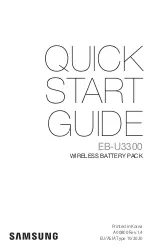
7
CHARGE RATE SELECTION VEC093
After the clamps are connected, plug in the charger to an AC outlet and the charger will show a circulating
pattern on the Digital Display. This pattern indicates power is applied. Press the ON/OFF button to prepare the
charger to change to an operating mode. Press the 2/10/20/40 A button and the charger will begin charg-
ing at 2 Amps. Pressing the 2/10/20/40A switch again will advance the charge rate to 10A, then 20A, then
40A. Pressing the switch again will turn OFF the charger output and the display will show the circulating pat-
tern, see Figure 4B.
Note that each time the charger rate is changed, the charger sounds a beep tone. The only time the selected
charge rate does not display at the full selected rate is when the battery is nearly full and charging at either
steps two or three. The display will be showing a slowing charge rate. To return to 2A, press the 2/10/20/40A
button. When the battery is fully charged, the charging Complete LED is lit and “FUL” is displayed on the
digital display.
CONNECTING IF BATTERY IS INSTALLED IN A VEHICLE
a) Check polarity of battery posts - For top-mounted battery connectors, the Positive post (marked POS, P, +)
usually has a larger diameter than the Negative battery post (marked NEG, N, -). For side-mounted battery
connectors, the terminals are marked Positive -red and Negative -black.
b) Attach charger clamps to battery connections, as follows, ensuring a good connection (if there is a mistake,
the Reverse Polarity Indicator will light): NEGATIVE-GROUNDED VEHICLE: Connect the POSITIVE (RED) charger
clamp to the POSITIVE (POS, P, +) ungrounded battery terminal. Then, connect the NEGATIVE (BLACK) charger
clamp to the vehicle chassis, or the engine block (away from the battery). Do not connect the clamp to the
carburetor, fuel lines, or sheet-metal body parts: connect only to a heavy gauge metal part of the frame or
engine block.
NOTE:
NEGATIVE-GROUNDED type systems are the most common in today's vehicles.
c) Set charger's Charge Rate to appropriate setting 2/10/20/40A according to battery size.
POSITIVE-GROUNDED VEHICLE:
Connect the NEGATIVE (BLACK) charger clamp to the NEGATIVE (NEG, N, -
) ungrounded battery post. Then, connect the POSITIVE (RED) battery clamp to the vehicle chassis or engine
part (away from the battery). Do not connect the clamp to the carburetor, fuel lines, or sheet-metal body parts:
connect only to a heavy gauge, stable metal part of the frame or engine block.
NOTE:
If there is any problem connecting the charger clamps to the battery terminals, contact the Vector
Technical Support Department toll-free at (866) 584-5504 for assistance.
d) Plug battery charger power cord into grounded AC power outlet and refer to Appendix A at the end of this
document for approximate charging times.
e) When charging is completed, disconnect cables and clamps in reverse order from which they were connected.
NOTE:
Use of Extension Cords
If it is necessary to use an extension cord, as is often the case, observe the following important safety information:
• Before using any extension cord, ensure that the wire size is at least 10 AWG for up to 100 feet and 8 AWG
for longer than 100 feet.
• Use only a good quality, good condition, UL-approved extension cord, and ALWAYS connect charger to the
extension cord before plugging the extension cord into a 110/120 volt AC power outlet. The use of a poor
quality extension cord or one that is not in good repair could cause fire and/or electric shock.
• Use a three-wire extension cord with a 3-prong plug and 3-conductor socket.
VEC093
A062003






























